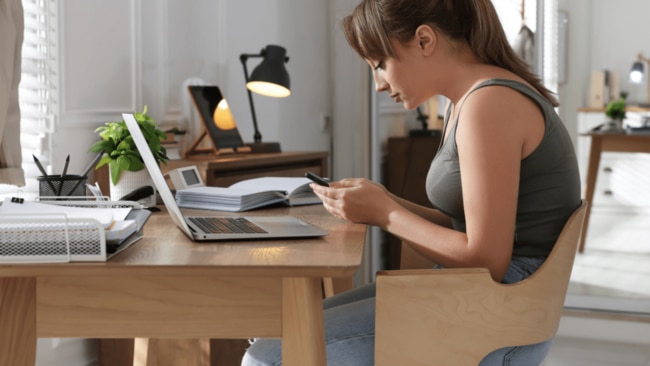Can a workout actually undo the damage of a desk job?
Are we doomed to slouch forever?

Lifestyle
Don't miss out on the headlines from Lifestyle. Followed categories will be added to My News.
Getting a jumpscare every time you see what you look like sitting at your desk? Correcting your posture to limit back, neck and shoulder pain can feel impossible. Luckily, there are loads of simple exercises to undo the damage.
If the shooting pain in your neck regularly reminds you of your prawn-like posture while at work, you’re not alone.
Many of us are aware of the strange ways we contort our bodies while sitting at our desks for eight hours a day, yet struggle to focus on sitting up straight for more than 10 seconds.
We’re already worried about battling the dreaded tech neck, phone pinky and texting thumb that social media frequently warns us of, we really don’t need to add our posture to our list of screen time-related concerns.

Uncomfortable and strange-looking posture correctors are getting more popular, but a new workout approach may be all you need to improve your posture.
How desk jobs affect our bodies
Sitting in front of a computer for hours at a time affects more than just our posture.
Even though our eyes are constantly moving between spreadsheets, documents and emails, it’s pretty likely we’re not blinking as much as we usually would while staring at a screen. This can cause dry and itchy eyes, sometimes affecting our vision.

Typing can be a workout, especially if we’re sending particularly impassioned emails. The position of our wrist while typing can cause carpal tunnel syndrome, triggering pain in our wrists and fingers.
Sitting for hours and hours unsurprisingly isn’t great for our hips, and our hip flexors can shorten, while our back, shoulders and neck can stiffen.
Maintaining poor posture in a non-ergonomic chair can also cause our spinal discs to compress, triggering pretty severe pain.

Blood can pool in our legs when we don’t move enough, and our circulation can take an extra hit if we consistently sit with crossed legs, putting us at risk of developing varicose veins.
Our muscles may also get too much of a stretch if we slouch, causing neck, shoulder or back pain.
Needless to say, we all really need to figure out how to maintain good posture while we’re working.

Do we need to fix our posture?
Physio Ash Ormond urges that there’s no such thing as ‘bad posture’, telling Body+Soul, “I don’t believe in the idea that your posture causes damage. Desk work isn’t inherently harmful, just like lifting heavy things isn’t either. The issue tends to arise when we stay in one position for too long without moving or doing anything to counterbalance it.”
So if you aren't experiencing any pain or discomfort while working, the expert says, “rather than trying to ‘fix’ your posture, it’s more helpful to ask why you’re wanting to change it.”
“For some people, particularly young women, I find it's mostly about aesthetics and body image. And while there’s a lot we can do to support and strengthen posture, it’s also worth noting that some aspects of posture like Dowager's humps and scoliosis can have genetic components, and not everything is always changeable.”

Workouts to undo the damage of our desk jobs
But if you constantly have the aches and pains of someone 40 years your senior while at work, or keep catching your body crumpling into an unnatural position at your desk, movement may be all you need to improve your posture and reduce discomfort.
Co-founder of Kic, Laura Henshaw says, “incorporating some gentle movements in your day can help make all the difference. Start with mobility exercises like Kic’s Desk worker stretch which focuses on releasing tightness with targeted stretches for the pecs, lats, hip flexors, and chest, along with thoracic mobility, cat-cow, and glute stretches.”

“Try incorporating strength and Pilates into your routine too, to target your upper back and core muscles, which can help with maintaining “good” posture. Strengthening these areas is key for supporting your spine and preventing discomfort, especially if you’re sitting for long periods.”
If you’re after a workout that doesn’t feel like a workout after a long day at work, classes such as aerial yoga may be your new go-to.
Jade Rodriguez from Luxe Yoga + Fitness tells B+S, “Aerial yoga can be especially beneficial for people who sit at a desk all day by addressing the physical and mental strain caused by prolonged sitting at a desk.”

She explains the practice can help to strengthen the core, back and shoulder muscles, improve mobility to reduce stiffness, boost circulation, decrease lower back pain and decompress our spines, to “counteract the spinal compression and poor posture caused by sitting for long hours.”
Ormond says what we really need is “ a routine that helps your body feel supported. Regular movement breaks throughout your day, stretching and self-release, and changing positions frequently all keep your body fluid, and can help prevent it from tightening into less optimal postures.”
“Movements like opening up through the chest, mobilising your upper back thoracic extension and rotation, and strengthening your postural muscles like your rhomboids and deep neck flexors can be really helpful to counteract desk work”, she adds.

If you’re feeling pain, tension or uncomfortable stiffness, it may be a good idea to see a physiotherapist or exercise physiologist to figure out which aspects of your posture are causing you issues.
The physio says, “posture is a whole-body thing. Sometimes what’s going on at your pelvis, core, or even the way you breathe can influence how you hold yourself.”
“At the end of the day, there’s no one-size-fits-all approach, or ‘fix’, but stretching regularly (like the Kic desk worker stretches), building strength, and tuning into your body’s needs is a much better approach than trying to chase the idea of ‘perfect posture.’”
More Coverage
Originally published as Can a workout actually undo the damage of a desk job?





